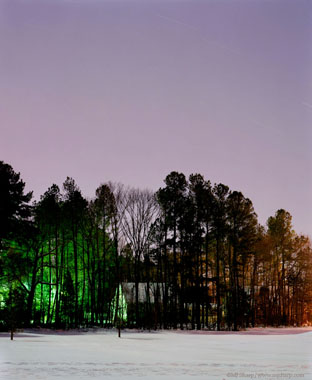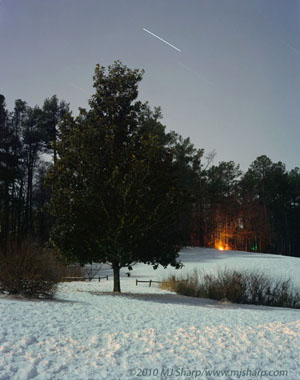A Night in the Life
An introduction
to the show Waiting in the Dark
Allen Building Gallery, Duke University
Fall Semester, 2010


While preparing for a winter shooting trip to Scotland, I made use of a rare Durham snowfall to conduct some film tests. My experience that night reminded me what I love about night shooting and why I've done nothing but long-exposure photography for the past 5 years.
The conditions that night were ideal for puzzling out final details for exposing scenes primarily by moonlight, which was the plan for my Scotland project. Around 10 pm, I set out from my house with all my camera gear in tow. As it turned out, I didn't travel far from home, but, as usually happens with this kind of shooting, I still went a world away. I began my night on a dark lane full of moon shadows. I stopped and watched from a distance as a tiny, transgressive band of humans built a fire in deep snow by a line of trees. At first bold in their building and stoking of the fire, their enthusiasm waned as they seemed to realize that they had no particular ritual to enact, no exalted narrative to replay. Midway through their activity I set up my camera, and their protean human fascination with fire became a small, Brueghelian aspect of a larger scene of dark meadow, fence, and tree.
Hours later and a few blocks away, I waited twenty minutes while my camera exposed a scene of human footprints across virgin snow. I availed myself of a nearby park bench that, while encrusted with ice, still counted as a rare amenity in my line of work. I sat, fascinated by how such a neutral activity as sitting on a park bench could feel so unorthodox when done in the middle of a frigid, inclement night. I waited through one film exposure and was well into waiting on my second one when I sensed something different in the environment. It wasn't quite a sound, and it wasn't quite movement, but it was something. A distance away was a small, shrub-lined ditch and beyond that a field. Within a minute or two, a handful of people, one pulling a sled, emerged from the field into my line of sight, crossed the road, and disappeared again. I had stared in that direction—attuned and attentive— without knowing exactly what I was waiting for, an experience one would be hard-pressed to have in the daytime.
When people ask me whether I'm afraid being out alone all night, it's that feeling of attentiveness I try to convey to them. Being fully alert is a very different experience than being fearful, and exercising a watchfulness that seems to issue directly from your brain stem is a sensation hard to come by in our overly-managed world. Additionally, when you stay put in a dark, mysterious environment instead of hurrying through it to some place of perceived safety, you yourself become a denizen of that environment. You are now an element of unknown motives and intent. You are now the thing to be watched. And that means that rather than being a timid, skittish creature, you are now a completely free animal in the world.
As heady an experience as that is, it's the aesthetic payoff of staying out all night that exerts the real pull. Bring a willing camera along, and it becomes the eyes that can actually see into the murky darkness. While sometimes I perceive a scene very much as it will record on film, oftentimes I'm only able to focus on one discernible element of what's in front of me, with lots of unclear, tonal shapes fully resolving and identifying themselves only later in the processed film. In those cases, beyond a certain compositional "spider sense," I never know at the time exactly what the final photograph will be. After years of doing this work, however, my spider sense feels like a fully realized instrument, and I think I've developed a happy working relationship with "murk."
One might ask, though, why I work
this way at all when I could just as easily shoot in daytime
with a certainty of what's
out there and
for a fraction of the time it takes to render
the same scene at night. The answer to that question is complicated.
At first,
I photographed
at night because I, myself, wanted to be
out in the world when
it was at its most quiet, dark, and restful.
Later, though, I stayed out all
night because I loved the visual results.
At night the elements of a scene have a completely different relationship
with
each
other than
they have in the daylight. The continual
distraction of daytime details falls away, leaving only the bare bones
of a composition.
Additionally,
stars and planets leave their trails across
the sky. Colors
shift. Light-reflective objects seem, instead,
to emit their own light.
In other words, the visual vocabulary changes
utterly. And rather than
loudly proclaiming its contents, as a daytime
composition would be tempted to do, the nighttime version speaks sotto
voce,
only whispering
its impression of what was there.
To web gallery of Waiting in the Dark show
Map of Duke's west campus (with Allen Building highlighted)